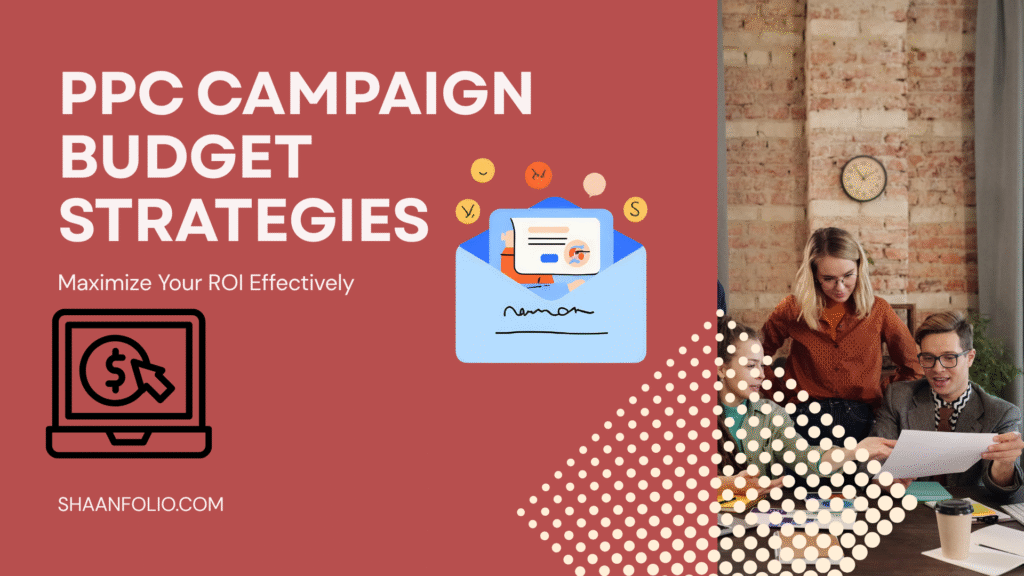Running a pay per click campaign can feel like walking into a casino. You drop money into ads, cross your fingers, and hope for ROI. But here’s the truth—PPC isn’t about luck. It’s about strategy.
And no part of your strategy matters more than your budgeting.
Whether you’re a startup founder trying Google Ads for the first time or a marketing manager scaling Facebook campaigns across product lines, one thing is constant: if you don’t have a budget plan, your pay per click campaign will burn through cash fast and leave you wondering what went wrong.
This guide walks you through a practical, no-fluff budgeting framework that works—regardless of your industry, platform, or experience level. Let’s break it down.

Table of Contents
Why Budgeting is the Heart of Every Pay Per Click Campaign
At its core, a pay per click campaign is simple: you pay when someone clicks on your ad. Sounds fair, right?
But here’s the catch—not all clicks are created equal.
Some clicks convert. Some just cost you money. And some disappear into the internet void, never to be seen again. That’s why budgeting is more than setting a daily limit—it’s about making sure your spend directly supports your goals.
A strong budget strategy:
- Aligns your ad spend with your actual business objectives
- Prevents overspending on high-competition keywords that don’t convert
- Gives you the flexibility to test, learn, and scale intelligently
- Helps you prioritize high-performing campaigns and pause the underwhelming ones
- And most importantly—it helps you track ROI, not just activity
Step 1: Get Super Clear on Your Campaign Goals
Before you spend a rupee or a dollar, pause. What are you really trying to accomplish with this pay per click campaign?
Not just “get more traffic”. That’s too vague.
Ask yourself:
- Are you launching a new product and need to drive early sales?
- Do you want to build a lead pipeline for your sales team?
- Are you trying to increase foot traffic to your local store?
- Or is this campaign about building brand awareness?
We worked with a SaaS company recently that said their goal was “acquisition.” But when we dug deeper, we realized their churn was high, and their actual priority was retention. That shifted their entire campaign from acquisition-focused landing pages to educational content and free trials. Same budget. Very different results.
👉 Pro tip: Set measurable goals. Think:
- “Get 500 downloads in 30 days”
- “Achieve a 5:1 ROAS”
- “Generate 100 qualified leads for our webinar”
A well-defined goal shapes your keyword strategy, audience targeting, and how much budget you’ll need to allocate for your pay per click campaign to succeed.
Step 2: Know Who You’re Talking To (And Who Else Is Talking to Them)
Let’s be honest—if you try to reach everyone, you’ll reach no one. A successful pay per click campaign starts with understanding your audience.
Get clear on:
- Their demographics (age, location, profession)
- Their interests and buying behavior
- What they search for and why
But it’s not just about knowing your audience—you need to know your competition too.
Use tools like SEMrush, SpyFu, or even Google’s Auction Insights to figure out:
- Who else is bidding on your target keywords?
- How aggressive are their budgets?
- What kind of messaging are they using in their ads?
This helps you estimate your costs, avoid bidding wars, and spot gaps where you can win with smart targeting or more relevant offers.
👉 Remember: You don’t always have to outspend your competitors—you just have to outsmart them.
Step 3: Do Smart Keyword Research (Not Just Obvious Ones)
Keywords are the engine of every pay per click campaign. Choose the wrong ones, and you’ll attract unqualified clicks. Choose wisely, and you’ll convert.
Start by brainstorming obvious terms people use when searching for your product or service. Then, dig deeper.
Tools to help:
- Google Keyword Planner (free and powerful)
- Ubersuggest
- Ahrefs or SEMrush
- AnswerThePublic for content angle ideas
Look for a healthy mix of:
- High-intent keywords (e.g., “buy running shoes online” vs. just “shoes”)
- Long-tail keywords (lower volume, less competition, often higher conversion rates)
- Branded keywords (your company name, competitors, product names)
Once you have a list, map those keywords to your campaign goals. For example, if your goal is lead generation, focus on solution-based search terms like “best CRM for small businesses” rather than broad terms like “CRM.”
👉 Your keyword choices will directly shape how much your pay per click campaign costs—and how well it converts.
Step 4: Estimate a Realistic Budget (Not Wishful Thinking)
Now comes the part that trips up most marketers: figuring out how much to spend.
Skip the formulas. Here’s a better, more intuitive way to plan your pay per click campaign budget:
Ask yourself:
- How many sales or leads do I need?
- What’s the average value of each conversion?
- How much can I afford to spend to get one conversion?
- How many clicks do I need to get those conversions?
- What’s the average cost per click in my industry?
Let’s say your goal is 100 new customers. If you usually convert 1 out of 20 clicks, that’s 2,000 clicks needed. If your average cost per click is ₹50 (or ~$0.60), then you’ll need around ₹100,000 ($1,200) for this campaign.
This kind of backwards budgeting ensures your campaign is rooted in actual performance expectations, not guesswork.
👉 Don’t forget to factor in testing, learning, and scaling — reserve 10–15% of your budget for experiments.
Step 5: Break Your Budget Into Smarter Pieces
One of the biggest mistakes we see? Blasting your entire budget into one giant campaign.
Instead, break your budget down by:
- Campaign objective (lead gen, sales, remarketing, awareness)
- Audience segments
- Keyword themes or categories
- Platforms (Google vs. Facebook vs. YouTube)
This lets you monitor what’s working and what’s not — so you can scale what’s performing and cut what’s not.
Example: Maybe your retargeting campaign on Facebook is crushing it with a low cost-per-acquisition (CPA), while your cold traffic on Google is bleeding money. Now you know where to double down.
Step 6: Choose a Bidding Strategy That Matches Your Brain, Not Just the Algorithm
Google and Facebook love to suggest automated bidding. And it can work—but only when your data supports it.
Here’s a simple breakdown:
- Manual CPC: Best if you want control and have limited data
- Maximize Clicks: Great for traffic campaigns, but not always quality
- Target CPA: Good for lead gen once you have enough conversions
- Target ROAS: Ideal for e-commerce if you’re tracking revenue
- Enhanced CPC: A middle ground—gives the algorithm some control
Start simple. Don’t overcomplicate bidding strategies until your pay per click campaign has collected some real performance data.
Step 7: Monitor Like a Hawk (Especially in Week 1)
PPC isn’t set-it-and-forget-it. Your campaign should be treated like a live experiment—one that needs close monitoring.
Key metrics to track:
- Click-through rate (CTR) – Are your ads appealing?
- Conversion rate – Are people taking the action you want?
- Cost per conversion – Are you spending wisely?
- Impression share – Are you being seen enough?
- Search terms – Are irrelevant clicks wasting your budget?
👉 Pro tip: In week one, check your campaigns daily. After a few weeks, switch to weekly performance reviews.
Tools to use:
- Google Ads Dashboard
- Google Analytics
- Looker Studio for easy reports
- Hotjar (to see user behavior post-click)
Step 8: Optimize Ruthlessly and Scale Intelligently
Once the data starts rolling in, it’s time to optimize.
Here’s what we typically recommend:
- Increase budget on high-performing campaigns and keywords
- Lower bids or pause underperformers
- Add negative keywords to filter out junk clicks
- Test new ad copy, creatives, and landing pages
- Try new targeting options or platforms
- Adjust your bids by device, time of day, or location
Optimization never ends—it evolves with your data. The best pay per click campaigns are living strategies, not one-time launches.
🔁 Bonus: Budgeting Hacks for Pay Per Click Campaigns
- Use daily and monthly caps to avoid runaway spend
- Batch-test new ads in small ad groups before rolling out wider
- Segment branded vs. non-branded keywords in separate campaigns
- Create a remarketing budget for warm audiences — they convert better
- Always set aside 10% of your budget for testing — new creatives, offers, or formats
- Use ad scheduling to avoid showing ads during low-converting hours
- Track everything. Even failed tests tell you something.
🚀 Final Thoughts: Strategy First, Spend Second
Launching a pay per click campaign without a budget strategy is like driving cross-country without a map. You might get somewhere… but it won’t be fast, cheap, or efficient.
Instead, build your campaign around clear goals, smart keyword choices, and a budget that reflects your growth priorities—not just your ad account balance.
The good news? PPC gives you incredible control, real-time data, and scalability. When you plan your budget step by step, you’re no longer guessing. You’re investing with intent.
✅ Ready to Take Control of Your PPC Results?
Let’s make your next pay per click campaign your most profitable one yet.

